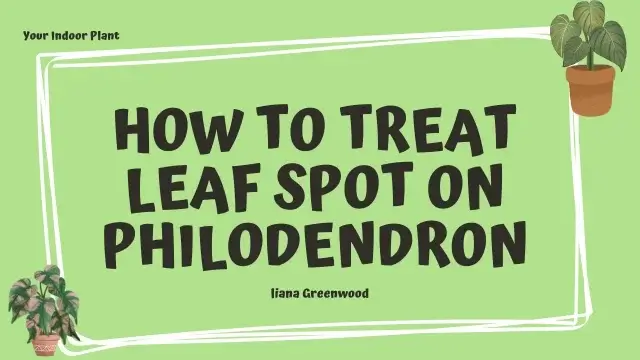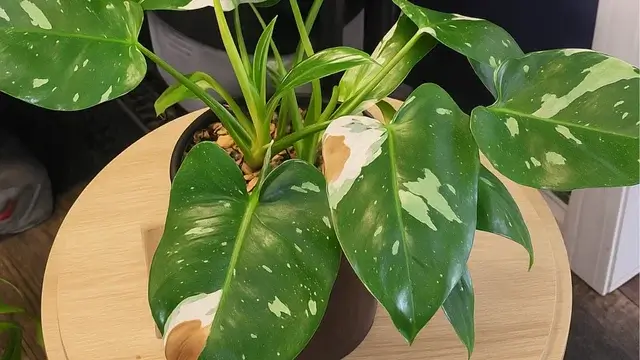How to Treat Leaf Spot on Philodendron: Easy Solutions

To treat leaf spot on philodendrons:
- Isolate the plant immediately
- Prune spotted leaves with sterilized tools
- Spray baking soda mix (2 tbsp/gallon)
- Improve air circulation around plant
- Adjust watering to prevent soggy soil
Most plants recover in 4-6 weeks with consistent care.
📌 Leaf Spot Quick Fix Summary
- Immediate Action (Day 1): Quarantine plant, remove brown spots on philodendron leaves
- Treatment (Week 1-2): Spray homemade solution twice weekly
- Recovery (Week 3-6): Monitor new growth, maintain proper care
- Prevention: Water at soil level, ensure good airflow
Leaf spot disease affects up to 60% of indoor philodendrons, according to plant pathology studies. With accurate diagnosis and consistent treatment, your philodendron will recover and thrive once again.
How to Identify Leaf Spot on Philodendron: Understanding Brown Spots on Your Plant
Philodendron leaf spot stems from two main culprits: bacterial and fungal infections. Both thrive in similar conditions but require slightly different treatment approaches.
How to identify bacterial leaf spot: Look for irregular brown spots on philodendron leaves with distinctive yellow halos around each spot. These water-soaked lesions often cluster together and spread rapidly through the plant.
How to identify fungal leaf spot: Creates more defined, circular brown spots with concentric rings. University of Florida research shows that fungal infections typically start smaller but can cover entire leaves if left untreated.
Environmental factors that trigger both types include:
- Overwatering and poor drainage
- High humidity with poor air circulation
- Water sitting on leaf surfaces
- Contaminated soil or tools
- Stress from temperature fluctuations
Home Remedies for Philodendron Leaf Spot: Natural Treatment Methods
Step 1: Immediate Isolation and Assessment
Move your affected philodendron away from other plants immediately. Leaf spot diseases spread through water droplets and air currents, so quarantine prevents further contamination.
Examine your plant thoroughly under good lighting. Count the affected leaves and note the spot patterns – this helps determine if you’re dealing with bacterial or fungal issues.
Step 2: Remove Infected Foliage
Using sterilized pruning shears, cut away all leaves showing spots. Make clean cuts at the base of each leaf stem.
Critical tip: Sterilize your tools with 70% rubbing alcohol between each cut. This prevents spreading pathogens to healthy tissue.
Dispose of removed leaves in household trash – never compost infected plant material.
Step 3: Apply Natural Treatment Solutions
Create an effective antifungal spray using these home remedies for philodendron leaf spot:
- 2 tablespoons baking soda
- 1 drop liquid dish soap
- 1 gallon lukewarm water
Spray this solution on all remaining foliage, including undersides of leaves. The alkaline environment disrupts fungal and bacterial growth cycles.
For stubborn infections, neem oil offers enhanced antifungal benefits. Follow manufacturer guidelines, usually applying once or twice weekly.
Step 4: Improve Growing Conditions
Modify watering habits: Check soil moisture with your finger – water when the surface feels dry to touch. Direct water toward the base of the plant instead of leaves to prevent moisture buildup on foliage.
Enhance ventilation: Set up a small oscillating fan within 3-4 feet of your philodendron to create gentle air movement around the entire plant. Good circulation prevents moisture buildup that pathogens need to survive.
Light conditions: Provide bright, indirect light. Stressed plants in low light recover more slowly from infections.
Is Leaf Spot Contagious to Other Houseplants?
Yes, leaf spot is highly contagious to other houseplants. Both bacterial and fungal pathogens spread through:
- Water droplets from watering or misting
- Air currents and ventilation systems
- Contaminated tools and hands
- Infected soil particles
Quarantine timeline: Keep affected plants isolated for at least 3-4 weeks after symptoms disappear. This prevents spreading to healthy plants in your collection.
Research shows that leaf spot can jump between different plant species, not just philodendrons. Spider plants, pothos, and monstera are particularly susceptible when grown near infected philodendrons.
Why Does My Philodendron Keep Getting Leaf Spot?
Recurring leaf spot infections usually stem from underlying care issues that weren’t fully addressed:
Common recurring causes:
- Persistent overwatering habits
- Poor air circulation in growing area
- Contaminated potting soil or tools
- High humidity without proper ventilation
- Stress from temperature fluctuations
What Is the Best Treatment for Leaf Spot Disease?

Research from the American Phytopathological Society shows that integrated treatment approaches work best for philodendron leaf spot recovery.
For bacterial infections:
- Copper-based bactericides show 85% effectiveness when applied early
- Hydrogen peroxide solutions (1 part 3% peroxide to 10 parts water) can reduce bacterial loads
- Improved drainage and reduced watering frequency are essential
For fungal infections:
- Baking soda solutions remain the safest, most effective home treatment
- Commercial fungicides containing propiconazole show excellent results
- Increasing air circulation reduces reinfection rates by up to 70%
The key is starting treatment within 48 hours of spotting symptoms. Delayed treatment reduces recovery success rates significantly.
Can Plants Recover from Leaf Spot?
Yes, philodendrons typically recover fully from leaf spot when treated promptly and properly. Plant pathology studies indicate:
- 90% recovery rate when treatment begins within 3 days
- 70% recovery rate for moderately affected plants (10-25% leaf loss)
- 35% success rate for heavily damaged plants (more than half the leaves affected)
📊 Philodendron Leaf Spot Recovery Timeline
Week 1-2: Remove infected leaves, apply treatments every 3 days
- Signs: Spots stop spreading, no new lesions appear
- Action: Continue baking soda spray applications
Week 3-4: Monitor new growth emergence
- Signs: Tiny new leaves begin forming
- Action: Reduce treatment frequency to weekly
Week 5-8: Healthy foliage development
- Signs: New leaves emerge spot-free, plant vigor improves
- Action: Resume normal care routine
Week 9-12: Complete recovery achieved
- Signs: Full foliage density restored
- Action: Maintain prevention strategies
Signs your philodendron is recovering include:
- No new spots appearing after 10 days
- Existing spots stop spreading
- New leaves emerge spot-free
- Overall plant vigor improves
Important: Plants with compromised root systems recover more slowly. Check roots for dark, mushy areas that indicate root rot – a common companion problem to leaf spot.
What Is the Best Fungicide for Philodendrons?
Safe, effective fungicide options for philodendrons include:
Organic options:
- Baking soda solutions (most economical and safe)
- Neem oil (broad-spectrum effectiveness)
- Diluted milk solution (1 cup milk mixed with 9 cups water)
Commercial fungicides:
- Copper-based products for bacterial issues
- Systemic fungicides containing propiconazole
- Biological fungicides with beneficial bacteria
Application tips:
- Apply during cooler parts of the day
- Ensure complete coverage including leaf undersides
- Reapply every 7-14 days as directed
- Stop treatment once new growth appears healthy
Avoid overuse of commercial fungicides, which can stress plants and create resistant pathogen strains.
Prevention Strategies That Actually Work
Prevention remains more effective than treatment. Research-backed prevention methods include:
Smart watering approach: Direct water to the soil surface while following the “wait and water” method. Let the top 1-2 inches of potting mix dry completely before the next watering session.
Quarantine new plants: Isolate new philodendrons for 2-3 weeks to monitor for disease symptoms before introducing them to your collection.
Regular plant inspection: Check plants weekly for early symptoms. Early detection increases treatment success rates dramatically.
Clean growing environment: Sterilize pots, tools, and surfaces regularly. Remove fallen leaves promptly as they can harbor pathogens.
Strategic plant placement: Arrange plants with sufficient distance between them to promote healthy air movement throughout your indoor garden. Crowded conditions promote disease spread.
When to Seek Professional Help
Contact a plant pathologist or extension service if:
- Multiple plants show symptoms simultaneously
- Treatments fail after 3-4 weeks
- Root rot develops alongside leaf spot
- Symptoms worsen despite proper treatment
Professional diagnosis can identify specific pathogen strains and recommend targeted treatments. You may want to read our Golden Crocodile Philodendron Care complete Guide.
Recovery Timeline and Expectations
Week 1-2: Focus on removing infected tissue and applying treatments Week 3-4: Monitor for new spot development; continue treatments Week 5-8: New growth should appear healthy; reduce treatment frequency Week 9-12: Full recovery with restored foliage density
Remember that some leaf scarring may remain permanent, but new growth should emerge completely healthy.
Conclusion
Treating leaf spot on philodendrons requires quick action, proper identification, and consistent care adjustments. With immediate isolation, removal of affected leaves, appropriate fungicidal treatments, and improved growing conditions, most philodendrons recover completely within 2-3 months.
The key to success lies in prevention through proper watering, good air circulation, and regular plant monitoring. By maintaining optimal growing conditions, you can prevent future leaf spot outbreaks and keep your philodendrons thriving for years to come.
🌿 Want your philodendron to bounce back faster? Bookmark this guide, follow the step-by-step treatment plan, and share your recovery progress with fellow plant enthusiasts. Your healthy, spot-free philodendron awaits!
